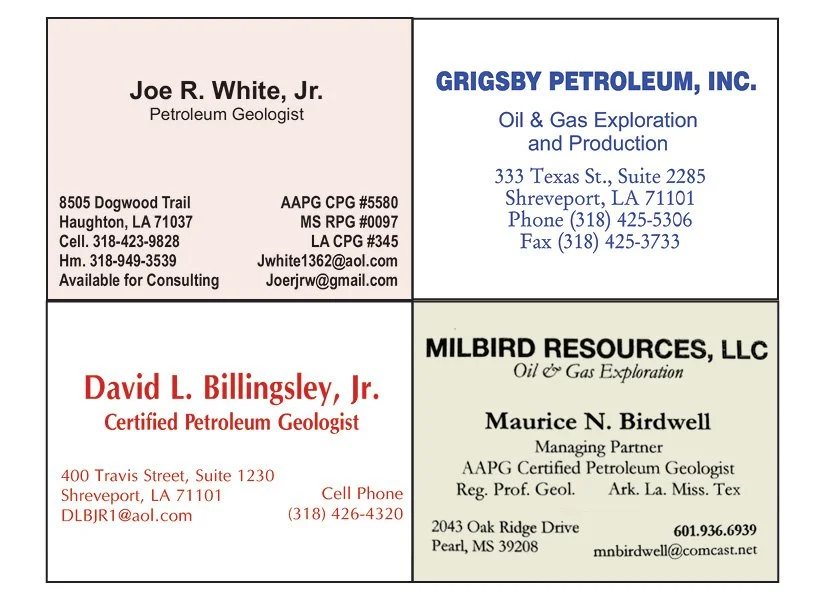The Sophistry of Wind and Solar as Baseload Power at the Utility Scale
Presented by: William D. DeMis
In-Person
Where: The Petroleum Club of Shreveport, 15th floor
Member Cost: $25 • Non-Member Cost: $35
SGS now accepts Tap Pay via Zelle for meeting payments!
If you’d like a seat, kindly use the form below to make your reservation by the preceding Friday.
We encourage members to invite guests, spouses, and friends to any of our meetings.
Virtual
Via Zoom
Member Cost: $10 • Non-Member Cost $15
**After checkout, you will receive an email with the Zoom Meeting details. You may sign up anytime before the meeting begins.
William D. Demis
William DeMis runs an oil-and-gas consultancy. He is an angel investor in a major domestic start-up company that aspires to drill some very important wildcats in the gulf coast.
Biography
William DeMis runs an oil-and-gas consultancy. He is an angel investor in a major domestic start-up company that aspires to drill some very important wildcats in the gulf coast. Bill likes to look at outside prospects, but he also likes to generate his own prospects for fun and, rarely, for profit.
Mr. DeMis has been employed as a work-a-day prospecting geologist for most of his 35 years, but he has also held important-sounding titles including: Exploration Manager at Marathon Oil, Exploration Vice President at Roxanna Oil, and Senior Vice President and Chief Geologist at Goldman Sachs.
Bill has received two Best Paper Awards from the AAPG for his analysis of the effects of US dollar exchange-rate variations on the value of oil on global markets. He has also won also “best paper” awards from Rocky Mountain Associations of Geologists and from the GCAGS when it was hosted in Shreveport.
Abstract
Anthropogenic Global Warming (AGW) is real. However, the perceived “direness” of impending AGW “doom” does not magically transform wind and solar power into viable electricity solutions for baseload power. Technology companies understand the math in comparing power systems and are investing heavily in nuclear power. Bill Gates contracted to restart a Three Mile Island reactor. Amazon is investing in small modular reactors (SMR). Google is funding SMR startup Kairos. Tellingly, not one of the big tech “gurus” ever offered to bail out any of financially failing offshore wind projects of the Northeast in exchange for their electricity.
Wind and solar have been wildly over-promoted as a “solution” to AGW. The great Energy Addition (not Energy Transition) will include wind and solar as countries, communities, and individuals continue to de-carbonize – to the extent they can. But wind and solar will only be an ancillary, boutique component of the Energy Addition; they will never be deployed to the scale envisioned by their acolytes. Wind and solar are outstanding sources of micro for third world counties or for isolated consumers in first world countries with minimal electricity requirements. (Only China has deployed meaningful solar power generation, but China backstops solar’s intermittent power with massive CO2- and particular-matter belching coal-fired electricity. This is not exactly a “carbon-neutral” system that anyone who cares about AGW ought to embrace as a model for the US.
Readily available information published by the US Federal Government agencies (e.g., Department of Energy) and from the National Renewable Energy Laboratories (NREL) allows anyone to construct a table comparing the costs, longevity, and areas occupied for wind, solar, natural gas with carbon captures and nuclear energy systems, normalized to a 2.5-gigawatt utility scale. This talk presents that table. It is eye-opening.
Using middle-school math and government reports, anyone can show that natural gas with carbon capture is the cheapest utility-scale power source ($17.1 billion), whereas utility-scale wind and solar machines would cost $14.46 and $34.6 billion respectively. Utility-scale nuclear power (Generation III reactors, not the even-cheaper, sexy SMRs everyone is talking about today) would cost $21 billion.
While at first glance, wind machines might appear cheaper, both wind and solar require massive battery back-up. The NREL data shows that 5 days of back-up for wind and solar machines would cost an additional $96 billion. Most wind or solar “droughts” last for months.
However, a table showing the cost of constructing utility-scale electricity systems does not accurately depict the total costs of each system to society because that table does not capture the useful life of the various machines. Wind and solar machines last 25 years and then they are junk. Natural gas lasts for 40 years. Nuclear power plants (Gen. III) have a useful life of 80 years. Thus, to normalize wind and solar’s costs to a nuclear power plant, their costs need to multiplied by 3.2. So when normalized to the cost of building a nuclear power plant, wind and solar would cost $46 billion and $110 billion respectively - not including battery back-ups.
Wind and solar are “renewable power” - but only in the strict sense that every generation of Americans has to re-build or “renew” the entire systems. A better term for wind and solar might be “perpetually rebuilt energy.”
Wind and solar have other serious deficiencies. Wind and solar machines are monster consumers of resources and land. As the DOE (2015) has shown, when electricity generation systems are normalized to terawatt-hours produced, wind machines require 8 times more fabricated material than a natural gas power plant and 10 times more material than a nuclear power plant. Solar power plants require 13 times more fabricated material than natural gas power and 16 times more material than nuclear power.
Wind and solar machines capture very low-density energy, and so they cover vast areas and therefore have major impacts on the environment and human communities. At the utility scale build-out for each systems, wind turbines would be spread over 300,000 acres, solar panels would cover 80,000 acres, natural gas with carbon capture would cover 975 acres, and an atomic power plant, which as zero emissions and lasts for 80 years, would cover 2,000 acres.
Wind and solar machines’ CO2 emissions are not trivial. Their components are almost entirely manufactured in other counties: and in the case of solar panels from China, they are made with coal-power electricity. So American might not see wind and solar’s pollution, but that does not mean it does not exist. According to the DOE (2024), the life-cycle CO2 emissions for different power sources are as follows: onshore wind turbines produce 27 lbs of CO2 per KWh, solar panels produce 176 lbs per KWh, natural gas power with carbon capture produces 220 lbs CO2 per KWh, and natural gas without CCS produces 880 g CO2. Nuclear produces 11 lbs CO2 per KWh (DOE 2024). Green power is not so green as its acolytes profess.
Nuclear power is in every way superior power because it requires less material, less land, produces less CO2, and runs 24/7. Nuclear power plants take 10 years to build, according to a highly idealized scenario provided by the DOE. The reality is that just obtaining a Nuclear Regulatory Commission (NRC) “permit to build” a new reactor design takes 2 years and 15,000 man-hours of review by the NRC. Therefore, large-scale deployment of nuclear power will be decades away. Natural gas with carbon capture will be, per forces, the preferred power generation source for at least the next 25 years.







































